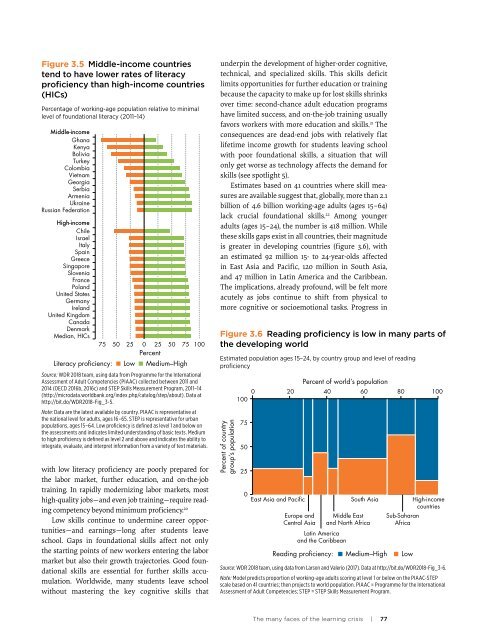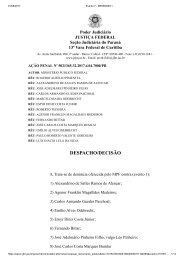Brasil só deve dominar Leitura em 260 anos, aponta estudo do Banco Mundial Relatorio Banco Mundial _Learning
You also want an ePaper? Increase the reach of your titles
YUMPU automatically turns print PDFs into web optimized ePapers that Google loves.
Figure 3.5 Middle-incomecountries<br />
tendtohavelowerratesofliteracy<br />
proficiencythanhigh-incomecountries<br />
(HICs)<br />
Percentage of working-age population relative to minimal<br />
level of foundational literacy (2011–14)<br />
Middle-income<br />
Ghana<br />
Kenya<br />
Bolivia<br />
Turkey<br />
Colombia<br />
Vietnam<br />
Georgia<br />
Serbia<br />
Armenia<br />
Ukraine<br />
Russian Federation<br />
High-income<br />
Chile<br />
Israel<br />
Italy<br />
Spain<br />
Greece<br />
Singapore<br />
Slovenia<br />
France<br />
Poland<br />
United States<br />
Germany<br />
Ireland<br />
United King<strong>do</strong>m<br />
Canada<br />
Denmark<br />
Median, HICs<br />
75 50 25 0 25 50 75 100<br />
Percent<br />
Literacy proficiency: Low Medium–High<br />
Source: WDR 2018 team, using data from Programme for the International<br />
Assessment of Adult Competencies (PIAAC) collected between 2011 and<br />
2014 (OECD 2016b, 2016c) and STEP Skills Measur<strong>em</strong>ent Program, 2011–14<br />
(http://microdata.worldbank.org/index.php/catalog/step/about). Data at<br />
http://bit.<strong>do</strong>/WDR2018-Fig_3-5.<br />
Note: Data are the latest available by country. PIAAC is representative at<br />
the national level for adults, ages 16–65. STEP is representative for urban<br />
populations, ages 15–64. Low proficiency is defined as level 1 and below on<br />
the assessments and indicates limited understanding of basic texts. Medium<br />
to high proficiency is defined as level 2 and above and indicates the ability to<br />
integrate, evaluate, and interpret information from a variety of text materials.<br />
with low literacy proficiency are poorly prepared for<br />
the labor market, further education, and on-the-job<br />
training. In rapidly modernizing labor markets, most<br />
high-quality jobs—and even job training—require reading<br />
competency beyond minimum proficiency. 20<br />
Low skills continue to undermine career opportunities—and<br />
earnings—long after students leave<br />
school. Gaps in foundational skills affect not only<br />
the starting points of new workers entering the labor<br />
market but also their growth trajectories. Good foundational<br />
skills are essential for further skills accumulation.<br />
Worldwide, many students leave school<br />
without mastering the key cognitive skills that<br />
underpin the <strong>deve</strong>lopment of higher-order cognitive,<br />
technical, and specialized skills. This skills deficit<br />
limits opportunities for further education or training<br />
because the capacity to make up for lost skills shrinks<br />
over time: second-chance adult education programs<br />
have limited success, and on-the-job training usually<br />
favors workers with more education and skills. 21 The<br />
consequences are dead-end jobs with relatively flat<br />
lifetime income growth for students leaving school<br />
with poor foundational skills, a situation that will<br />
only get worse as technology affects the d<strong>em</strong>and for<br />
skills (see spotlight 5).<br />
Estimates based on 41 countries where skill measures<br />
are available suggest that, globally, more than 2.1<br />
billion of 4.6 billion working-age adults (ages 15–64)<br />
lack crucial foundational skills. 22 Among younger<br />
adults (ages 15–24), the number is 418 million. While<br />
these skills gaps exist in all countries, their magnitude<br />
is greater in <strong>deve</strong>loping countries (figure 3.6), with<br />
an estimated 92 million 15- to 24-year-olds affected<br />
in East Asia and Pacific, 120 million in South Asia,<br />
and 47 million in Latin America and the Caribbean.<br />
The implications, already profound, will be felt more<br />
acutely as jobs continue to shift from physical to<br />
more cognitive or socio<strong>em</strong>otional tasks. Progress in<br />
Figure 3.6 Readingproficiencyislowinmanypartsof<br />
the<strong>deve</strong>lopingworld<br />
Estimated population ages 15–24, by country group and level of reading<br />
proficiency<br />
Percent of country<br />
group’s population<br />
Percent of world’s population<br />
0 20 40 60 80 100<br />
100<br />
75<br />
50<br />
25<br />
0<br />
East Asia and Pacific<br />
Europe and<br />
Central Asia<br />
Latin America<br />
and the Caribbean<br />
Reading proficiency:<br />
South Asia<br />
Middle East<br />
and North Africa<br />
Medium–High Low<br />
High-income<br />
countries<br />
Sub-Saharan<br />
Africa<br />
Source: WDR 2018 team, using data from Larson and Valerio (2017). Data at http://bit.<strong>do</strong>/WDR2018-Fig_3-6.<br />
Note: Model predicts proportion of working-age adults scoring at level 1 or below on the PIAAC-STEP<br />
scale based on 41 countries; then projects to world population. PIAAC = Programme for the International<br />
Assessment of Adult Competencies; STEP = STEP Skills Measur<strong>em</strong>ent Program.<br />
The many faces of the learning crisis | 77








